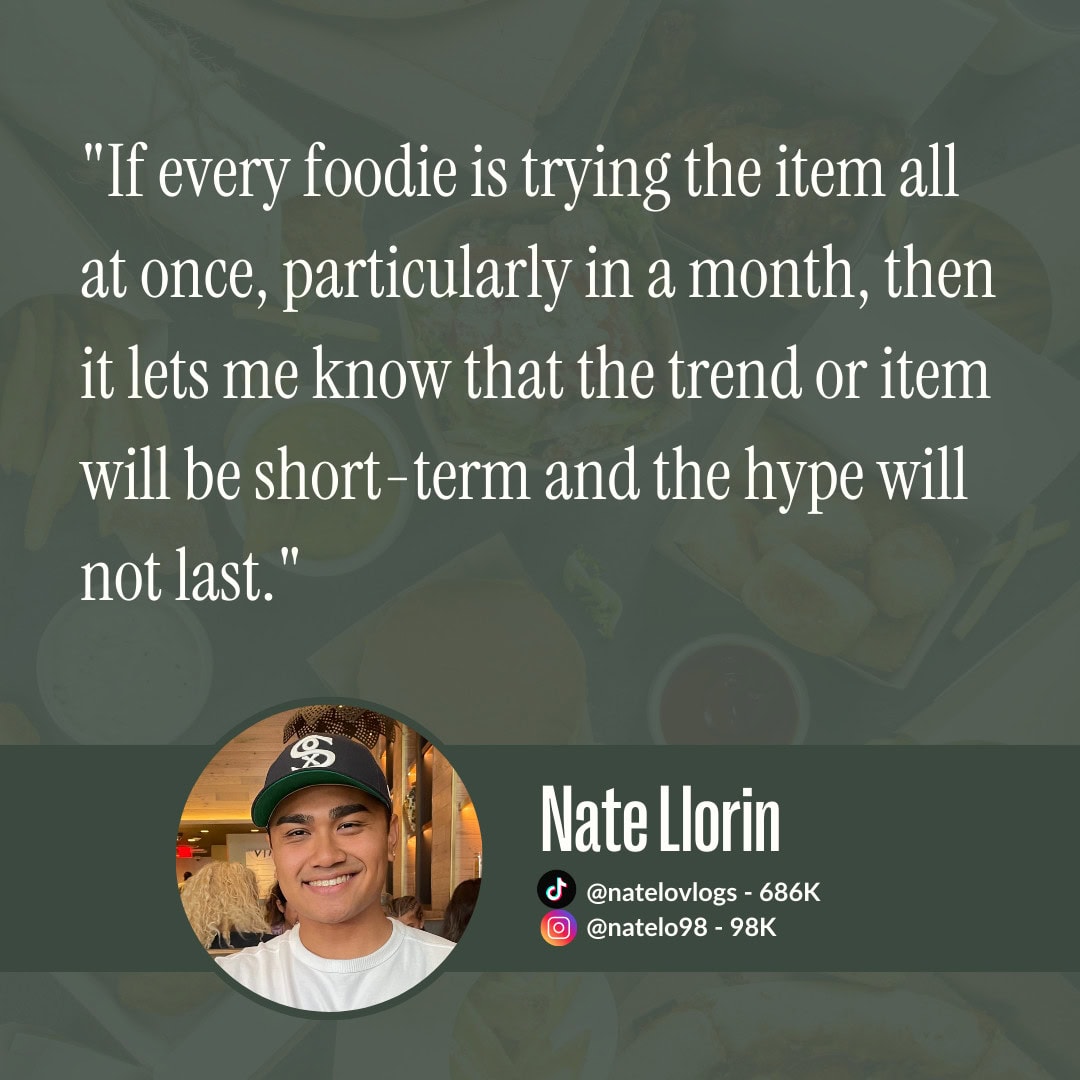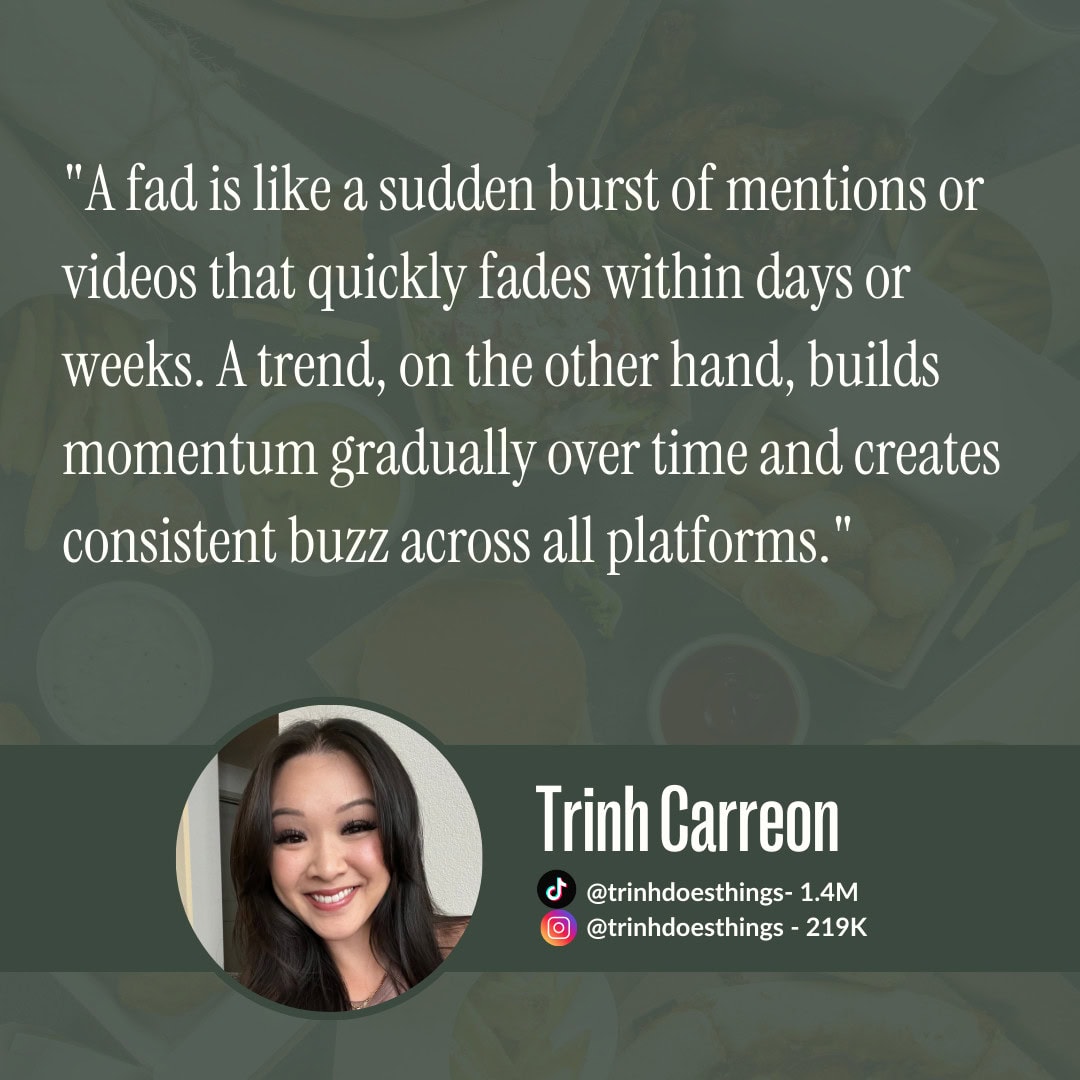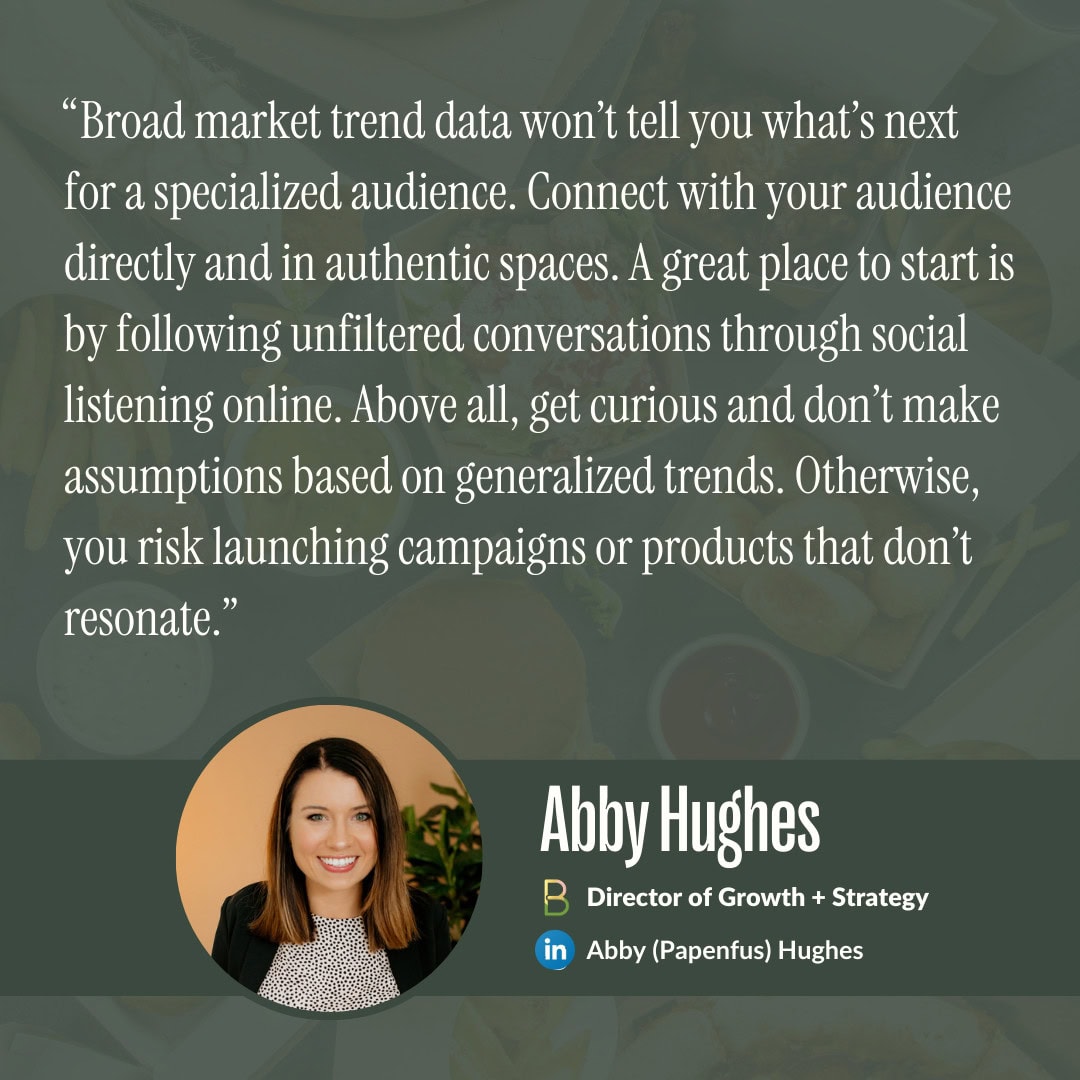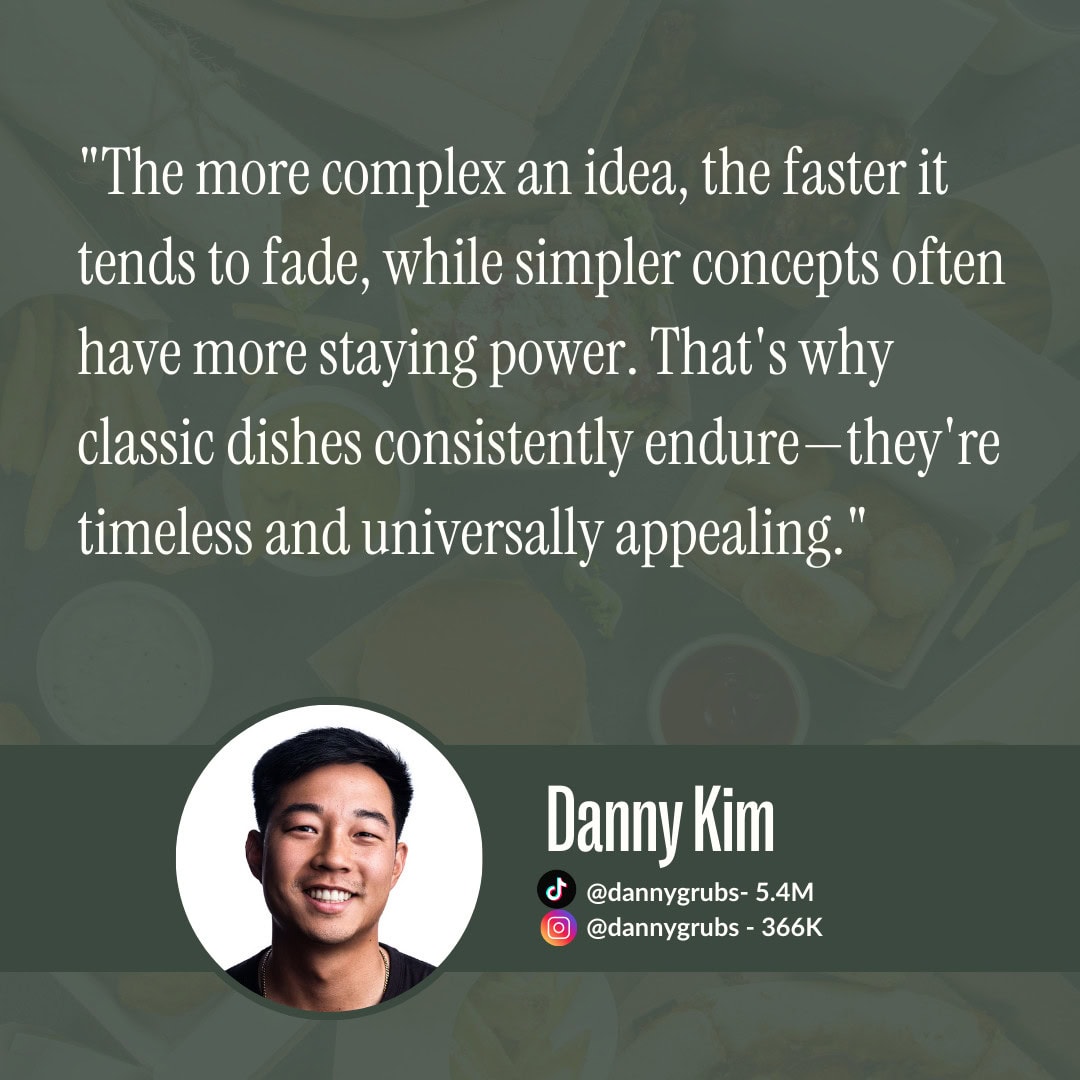Social media reflects the intersection of culture and commerce—what’s trending sells. But things change fast. One week, everyone’s lining up for cronuts; the next, they’re chasing down pickle-flavored everything.
What separates a fleeting food fad from a lasting culinary trend? And how can industry professionals learn to spot the difference?
Understanding shifts in consumer trends and behavior is essential for business health. Data from WTW shows that almost half (47%) of senior decision-makers in food and beverage companies say they are reviewing their business continuity plans every six months, and 31% are doing so quarterly.
We used Belle’s Brilli™ tool to ask leading foodie influencers how they navigate trends vs fads. Check out what they had to say, paired with insights from Belle’s strategists.
The Anatomy of a Food Fad

Food fads are like shooting stars in the culinary universe—big, captivating, but ultimately short-lived. Nate Llorin, a popular voice on Gen Z socials with connections to the fast food industry, offers a keen observation about identifying these temporary phenomena: “If every foodie is trying the item all at once, particularly in a month, then it lets me know that the trend or item will be short-term and the hype will not last.”
This concentrated burst of attention often follows a predictable pattern. As Llorin notes, people rush to try the latest viral sensation because they’ve seen their favorite food creators feature it. However, once they satisfy their curiosity, the conversation dies down, and they rarely return for seconds.
The Making of a Lasting Trend

In contrast to fads, trends demonstrate staying power through their gradual build and sustained presence. Trinh Carreon, an online foodie known for taste-testing LTOs and curating at-home recipes with trending ingredients, draws a clear distinction: “A fad is like a sudden burst of mentions or videos that quickly fades within days or weeks. A trend, on the other hand, builds momentum gradually over time and creates consistent buzz across all platforms.”
This slower, more organic growth often signals something more substantial than mere novelty. It suggests that the food item or concept has found genuine resonance with people’s tastes and lifestyles, rather than just their social media feeds or feelings of FOMO.
Trends vs Fads: Core Differentiation Factors
Growth Patterns
- Trends: Show sustained adoption across multiple years (e.g. U.S. retail sales of plant-based foods grew 6.2% from 2020 to 2021, in conjunction with a previous 54% three-year jump.)
- Fads: Experience rapid spikes followed by sharp declines (e.g. “baked feta pasta” saw over 2K social mentions from January – March 2021, selling stores out of feta. By April 2021, discussion was down 68%.)

Market Penetration
- Trends: Appear across multiple restaurant segments simultaneously (e.g. turmeric experiencing 195% growth across fine dining, casual dining, midscale and QSR menus)
- Fads: Remain concentrated in specific niches (e.g. black garlic growth primarily in fine dining)

Consumer Drivers
- Trends: Align with fundamental lifestyle shifts (e.g. obesity rate for U.S. adults declined two percentage points between 2020 and 2023)
- Fads: Rely on novelty/virality (e.g. “chamoy pickle” hit its peak virality in November of 2023, with kits selling out on TikTok shop. Online discussion was down 74% by mid 2024.)

Tracking Trends vs Fads on Social Media
While social media can amplify both trends and fads, it’s important to look at multiple metrics—not just virality—as indicators. As our experts suggest, the pattern of engagement often tells a more important story than the volume. A truly trending item will generate sustained conversation and achieve diversity.
Social metrics to evaluate trends vs fads:
- Track social mention volumes, sentiment and duration to identify trends maintaining >6 months of relevance
- Monitor adoption patterns beyond food creators into lifestyle, travel and other niches
- Analyze cross-generational appeal to determine if ingredients resonate across different age demographics
- Measure geographic spread to confirm organic multi-region adoption
Caveat for Niche Audiences

For businesses targeting niche audiences, distinguishing between trends and fads requires a different approach.
While broad market analysis typically relies on widespread adoption across diverse demographics and geographical regions, niche markets operate within their own distinct ecosystems.
A phenomenon that appears limited or temporary to the general market might represent a significant, lasting trend within a particular niche community.
Success in niche markets requires deep immersion in the community to understand the subtle distinctions between fleeting interests and emerging patterns that will reshape preferences.
This might involve tracking discussions in specialized media channels, consulting directly with core community members or influencers and employing new market research methods.
“The key is knowing where to look and what tools to use,” explains Abby Hughes, Director of Growth and Strategy at Belle. “Broad market trend data won’t tell you what’s next for a specialized audience. Connect with your audience directly and in authentic spaces. A great place to start is by following unfiltered conversations through social listening online. Above all, get curious and don’t make assumptions based on generalized trends. Otherwise, you risk launching campaigns or products that don’t resonate.”
When Do Fads Become Trends?
Being the first to jump on a movement can be a major business growth driver, but it involves risk, often requiring the adoption of a fad before the data shows it’s a trend.
Without knowledge of a fad’s staying power, launching an LTO or seasonal product is a strong way to test the market. This approach creates the perfect environment to gauge true demand beyond initial curiosity.
The “while supplies last” messaging creates urgency, while the limited run protects you from getting stuck with excess inventory or specialized ingredients if the item doesn’t resonate long-term.
The Simplicity Factor in Trends vs Fads

Metrics aside, popular tastemaker and chef Danny Kim offers a particularly insightful perspective on what makes certain food phenomena endure: “The more complex an idea, the faster it tends to fade, while simpler concepts often have more staying power. That’s why classic dishes consistently endure—they’re timeless and universally appealing.”
This principle of simplicity extends beyond just the food itself. Kim emphasizes that “at its core, social media is about people connecting with people.” When a food trend truly catches on, it’s often because it facilitates genuine connection and sharing among friends and family, not just likes and shares.
This element of trend vs. fad explains why nostalgic foods and IRL experiences are major trends for 2025. In an industry that’s constantly chasing the next big thing, sometimes the most valuable trends are the ones that remind us why we fell in love with food in the first place.
Navigating the Future of Food Culture + Commerce
Understanding the distinction between trends vs fads has become an essential skill in foodservice. While social media can amplify both phenomena, the key is to evaluate whether a new flavor or approach to food aligns with your target customers’ true preferences and shows sustained growth patterns.
Distinguishing between trends and fads requires careful observation and understanding of human behavior. While fads might offer short-term excitement, trends represent deeper shifts in how people think about and consume food.

